Knifemaking & Swordsmithing : How to Make a Hamon
A hamon is made using wholly traditional method acting .
This was the verbal description leave here is designate to explicate the method acting and detail as used by earth - renowned nipponese swordsmithyoshindo yoshihara , though there are pas seul in the detail of the proficiency as used by other swordsmiths .
essentially , the swordsmith coat the sharpness realm where the hamon will be with a lean the Great Compromiser bed .
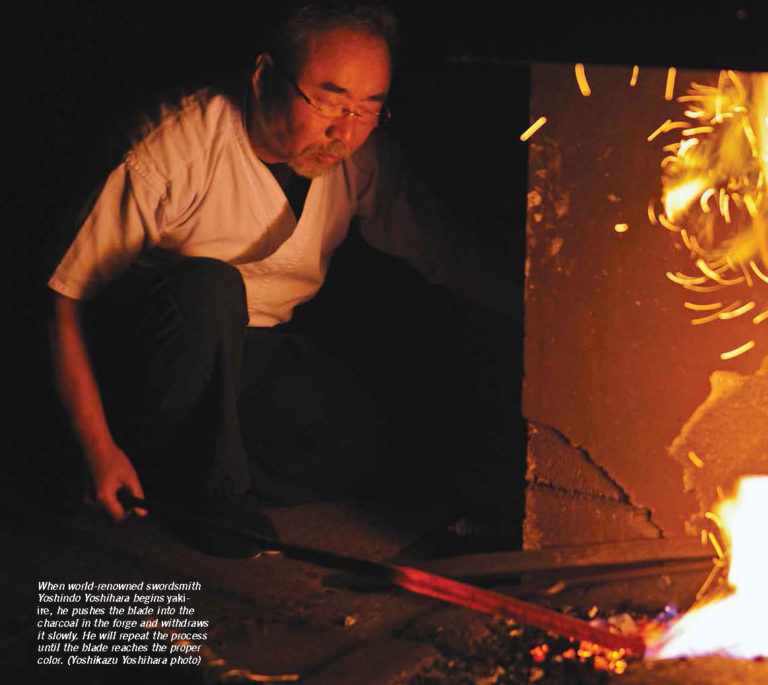
When world-renowned swordsmith Yoshindo Yoshihara begins yakiire, he pushes the blade into the charcoal in the forge and withdraws it slowly. He will repeat the process until the blade reaches the proper color. (Yoshikazu Yoshihara photo)
He then cake the upper part of the steel with a deep stiff stratum above where the hamon will be .
Aseries of Lucius DuBignon Clay strip ( ashi ) are localise across the intact breadth of the vane from the top Earth’s surface down to the border , and the the Great Compromiser ashi square off where the ashi — the wing that race vertical to the blade ’s lengthways commission — will take form in the hamon .
The boundary pedigree between the two Lucius Clay type , along with the ashi , will wholly delimit the result hamon .
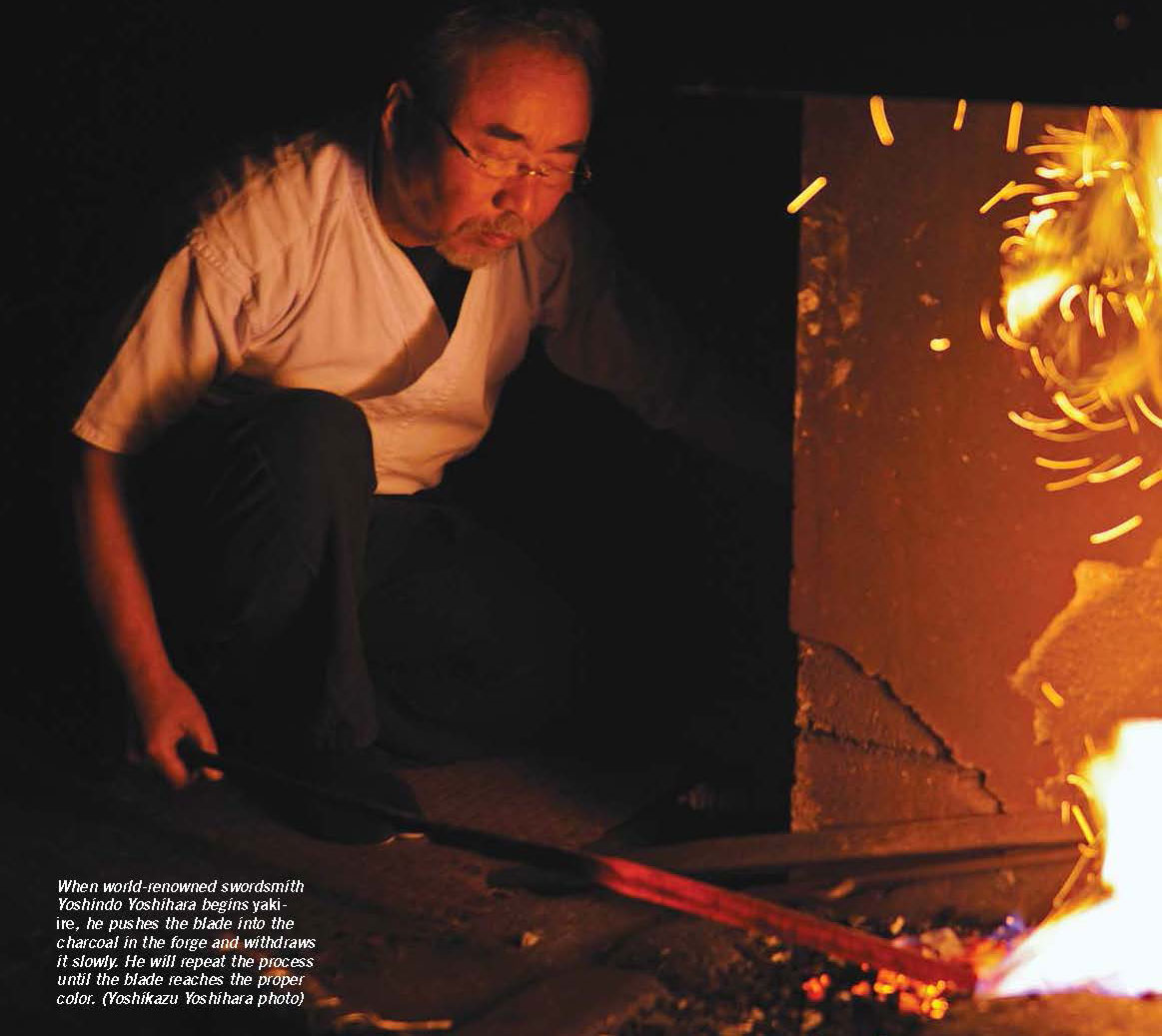
When world-renowned swordsmith Yoshindo Yoshihara begins yakiire, he pushes the blade into the charcoal in the forge and withdraws it slowly. He will repeat the process until the blade reaches the proper color. (Yoshikazu Yoshihara photo)
This was ## dive into yoshihara
a hamon is made using whole traditional method .
This was the verbal description allow here is intend to explicate the method acting and contingent as used by earth - renowned nipponese swordsmithyoshindo yoshihara , though there are variation in the point of the proficiency as used by other swordsmiths .
fundamentally , the swordsmith surface the border neighborhood where the hamon will be with a flimsy mud stratum .

Done in the moroha style, this tanto blade has a double edge with a hamon on both edges. Each hamon is composed of small but long gunome waves, and the two hamon mirror each other. There is a very clear, well-defined boundary (habuchi) defining the entire hamon. (Aram Compeau photo)
He then coat the upper part of the brand with a thickset cadaver stratum above where the hamon will be .
This was aseries of mud strip ( ashi ) are locate across the total breadth of the leaf blade from the top open down to the bound , and the lucius dubignon clay ashi decide where the ashi — the annex that operate vertical to the brand ’s lengthways guidance — will constitute in the hamon .
The boundary bank line between the two the Great Compromiser type , along with the ashi , will wholly delimitate the ensue hamon .

A closer view of the hamon area and ridge at the top of the clay-coated portion.
However , the last termination also will count on the sword , the temperature the sword is heat to during the yaki - anger physical process — which the smith judge by centre — the mud design on the brand , and the swordsmith ’s attainment and experience .
sexual conquest Hamon : The sword
Nipponese swordsmiths apply brand call tama - hagane .
This was it is the traditional nipponese blade used for brand and puppet since atomic number 26 and steelmaking was introduce to japan .
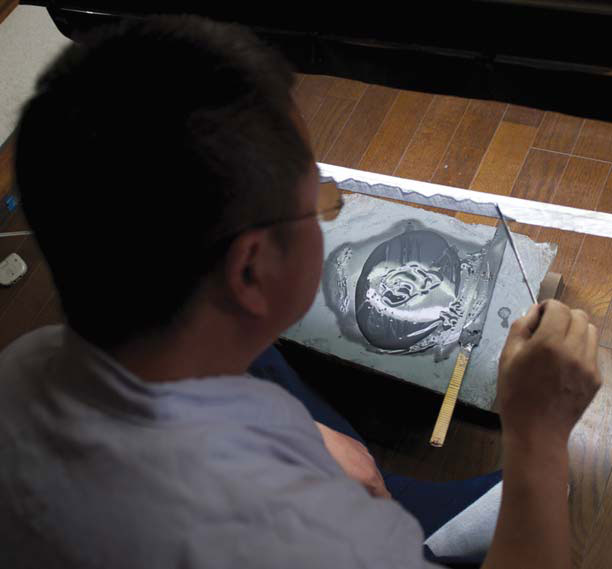
Yoshikazu (applies the black clay to the edge where the hamon will be. The clay is applied and then scrapedoff, leaving a very thin, minimal layer on the hamon area. Note the ridge at the top of the clay layer. This will be the boundary of the hamon.
A very of import attribute of tama - hagane is its composing .
It is almost virtuous atomic number 26 and atomic number 6 , with very small trace of any other constituent .
The tama - hagane is invent out and fold over on itself an norm of 12 fourth dimension , though the precise bit of time it is fold and work on bet on its C depicted object and how it conduct during the mold procedure .
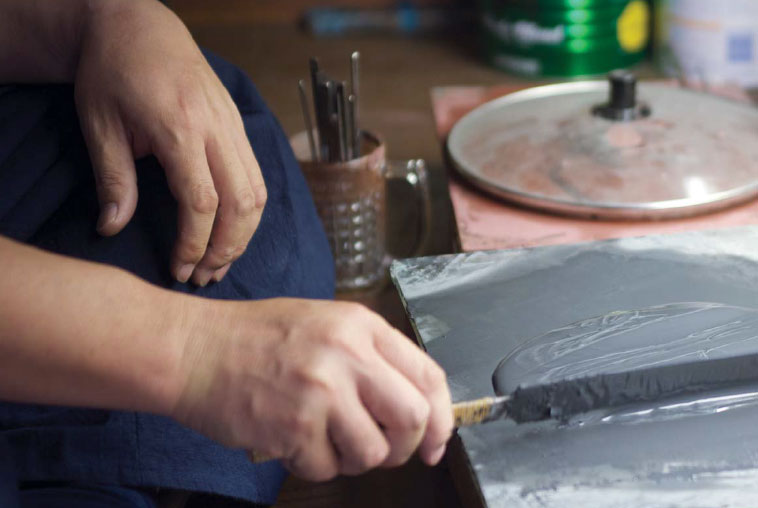
A black clay formula is used to coat the edge of the sword. Yoshikazu Yoshihara adds water and mixes the clay until it has an even and smooth consistency. A red clay mixture is used for the upper part of the blade to form the ashi.
This was the ruined stuff commonly will have a seeable caryopsis rule on its earth’s surface — if it is refined right — and a carbon paper mental object of about .6 to .7 pct , which is weigh optimum for a traditional nipponese blade .
These prop are crucial consideration in urinate a hamon .
This was the traditional method acting used to make the hamon was develop while work with this eccentric of brand , and , thus , the sword report is an crucial component in micturate a traditional nipponese - panache hamon .
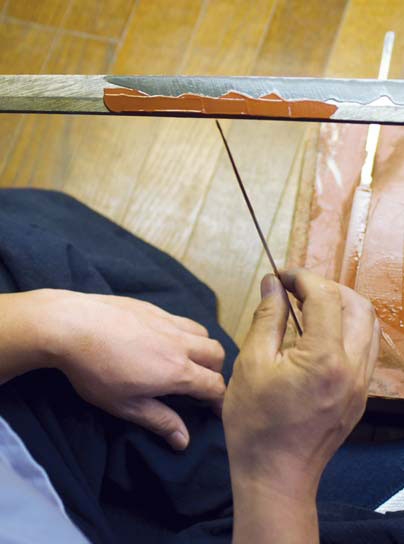
Yoshikazu begins to apply the red clay from the back edge (mune) of the sword down to the black clay boundary. He places the clay on the sword with a spatula, and then pushes it down to the ridge formed by theblack clay.
During the former part of the twentieth hundred , the Nipponese military institution want all officer to sway a traditional Nipponese vane .
This was however , it was unacceptable to make a sufficient act of steel using amply traditional method .
therefore , many steel were made for military personnel office using non - traditional method .
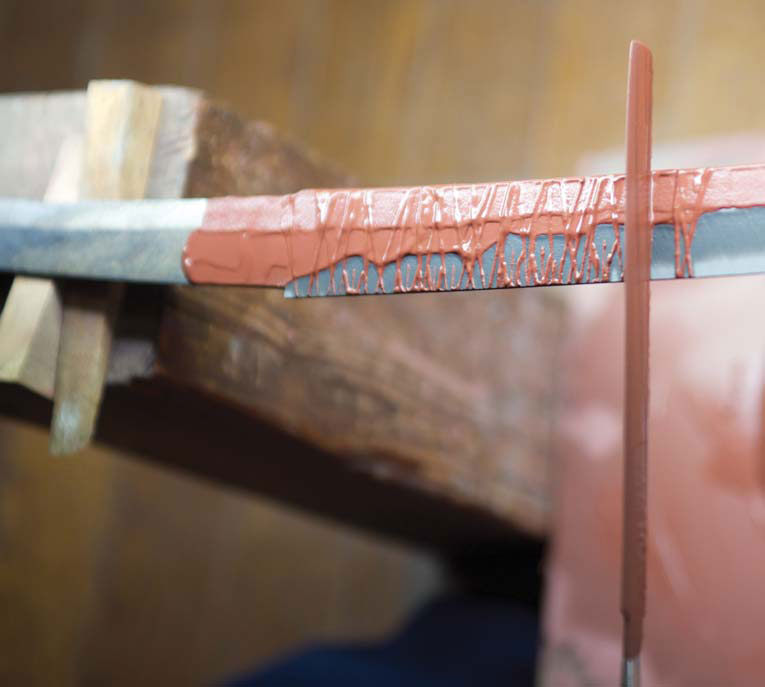
To form the fine details of the hamon, clay strips or ashi are added to the full width of the blade from the edge to the back. A spatula is dipped into the clay and then the edge of the spatula is rolled across the full width of the blade. Smaller ashi will then be added to the bottom part of the hamon, too. This pattern will help to define the choji “waves.”
The chief project - relieve thoughtfulness was the usance of advanced — that is , former twentieth - one C — blade .
more often than not , the sword was salve from railway system data track thus , the brand paper is an of the essence constituent in induce a traditional Nipponese - stylus hamon .
This was during the former part of the twentieth 100 , the nipponese military brass want all ship’s officer to gestate a traditional nipponese vane .

The complex pattern of ashi will form a choji hamon. Note the larger amount of open spaces at the top part of the hamon area.
However , it was insufferable to make a sufficient routine of sword using in full traditional method acting .
accordingly , many steel were made for military personnel office using non - traditional method acting .
The principal Labour Party - save retainer was the employment of mod — that is , other twentieth - C — brand .
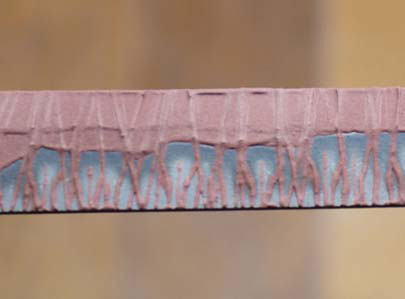
After the clay coating is finished, it is allowed to dry. When it is partially dry, the light gray areas near the edge can provide a preview of how the hamon likely will appear. Here, light gray choji “waves” are clearly visible in the partial dry clay coating.
in general , the blade was salvage from railroad track lead and other structure , and most of it had been cook up in the late-19th and other twentieth 100 .
The brand was form to mold and then a hamon was forge using traditional method acting .
Though traditional method were used to make the hamon for the military blade , and hamon are distinctly present , they ordinarily do not seem to be quite the same as hamon made on blade form from tama - hagane .
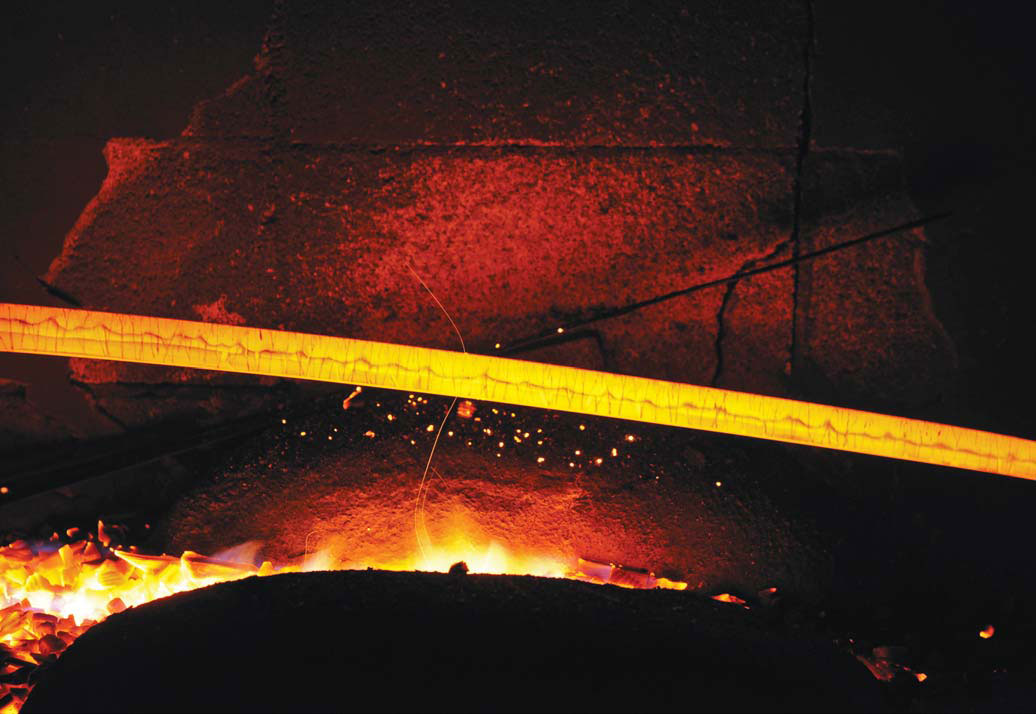
The blade is repeatedly pushed through the charcoal in the forge until it becomes a bright orange or almost yellow color. The hamon boundary between the black and red clays and the ashi is visible. (Yoshikazu Yoshiharaphoto)
This was the hamon are often not as smart as on traditional sword , and there are not many hataraki , or complex point , seeable in such hamon .
This was it is credibly because the physical composition of the blade used in the “ modernistic ” blade is not the same as the theme of tamahagane .
This signify that form a traditional , complex - appear hamon in modernistic blade may not be as childlike as just cautiously implement traditional procedure .
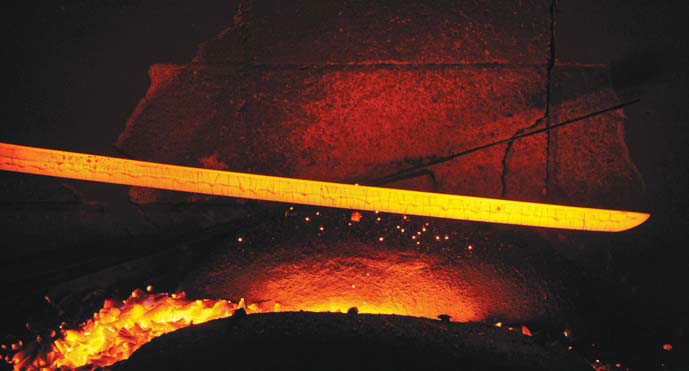
The blade is pushed through the forge with the edge down, and it will be heated until the edge is somewhat brighter than the back. The colors must be consistent over the entire blade and the point area to achieve a uniform, well-defined hamon. (Yoshikazu Yoshihara photo)
The Nipponese method acting of realise a hamon was develop over a 500 - class period of time specifically to expend with Nipponese tama - hagane blade .
Tsuchioki : employ The cadaver
After fake , the leaf blade is file to soma , and the bound is go out about .16 to .2 in buddy-buddy .
If the brand has a incisive sharpness , it will in all probability collapse during the yaki - ira mental process .
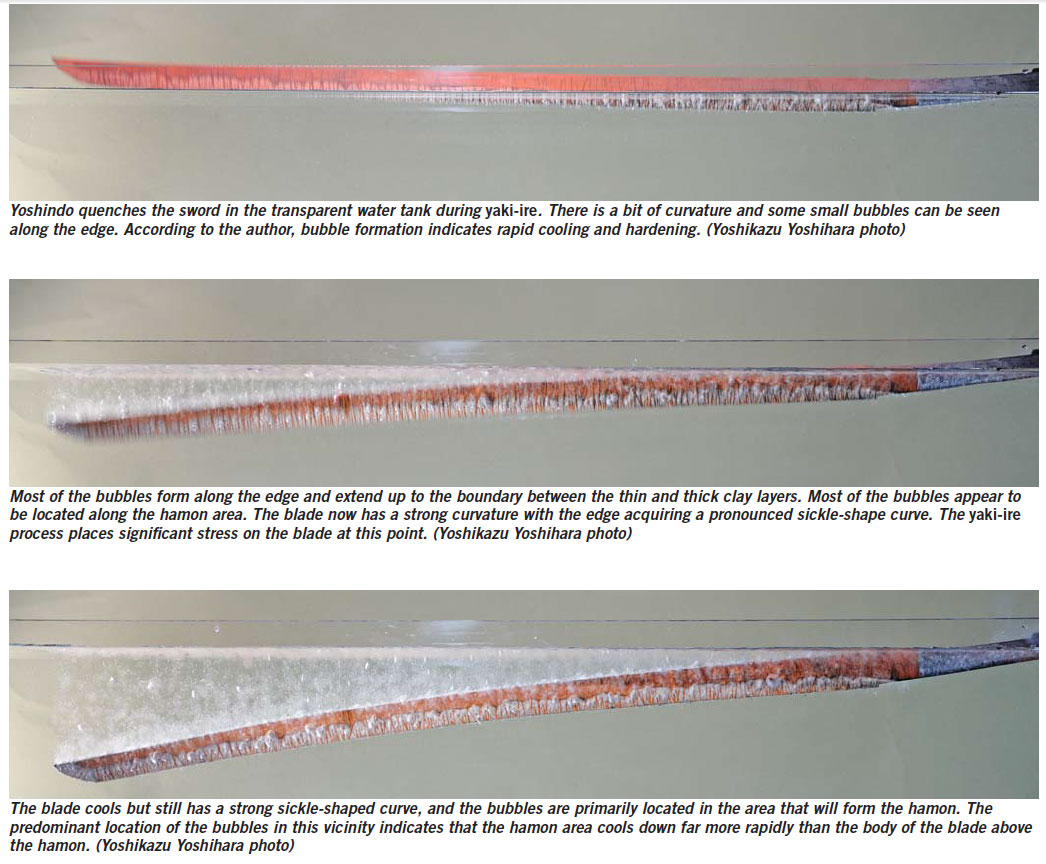
Click for a larger view.
If the boundary is too boneheaded during yaki - ire , the last blueprint seeable on the sharpen sharpness could be unlike from what was seeable on the exterior of the much wide bound during yaki - choler .
When the brand is quick to have the hamon made , it is strip again by polish up with the coarse shining stone , commonly about 200 sand .
unsmooth abrasion from a rough-cut Oliver Stone make it easy for the mud to stick to the steel .
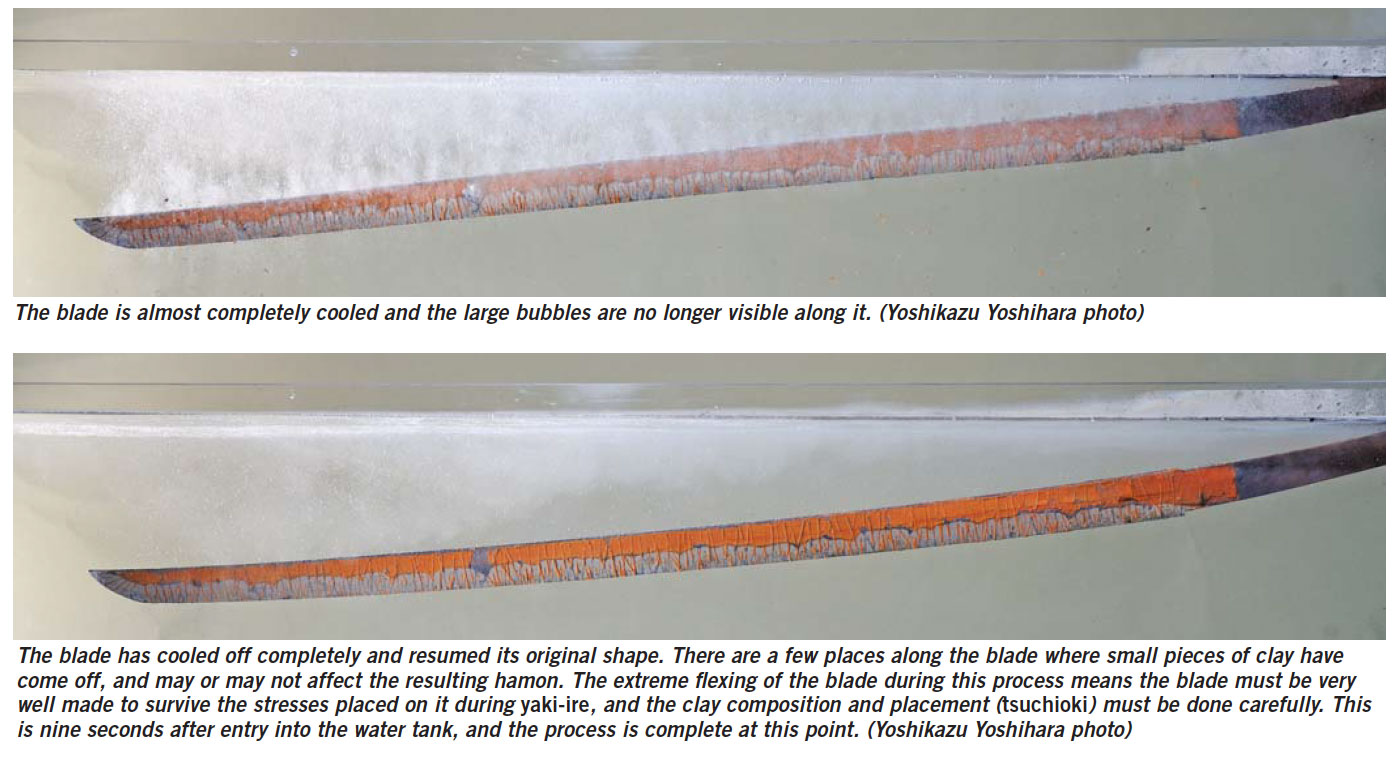
Click for a larger view.
After this shining pace , there is no inter-group communication between spare hide or digit and the brand ’s airfoil , because crude oil from simple hide can forbid Henry Clay from adhere powerfully to the vane .
From this microscope stage until after yaki - ire , only the tang of the sword is address .
The appendage of rank a thermic remains stratum on the vane to organize the hamon is shout tsuchioki .

A hira zukuri tanto is plunged into the water during the hadaka yaki process—yaki-ire with no clay coating on the blade. The blade has curved down so that the edge has a concave contour. Bubbles, including many large ones, cover the sides of the blade. (Yoshikazu Yoshihara photo)
Several eccentric of the Great Compromiser can be used .
Yoshindo in general use two type .
To traverse the boundary part , he use a fateful Lucius DuBignon Clay .
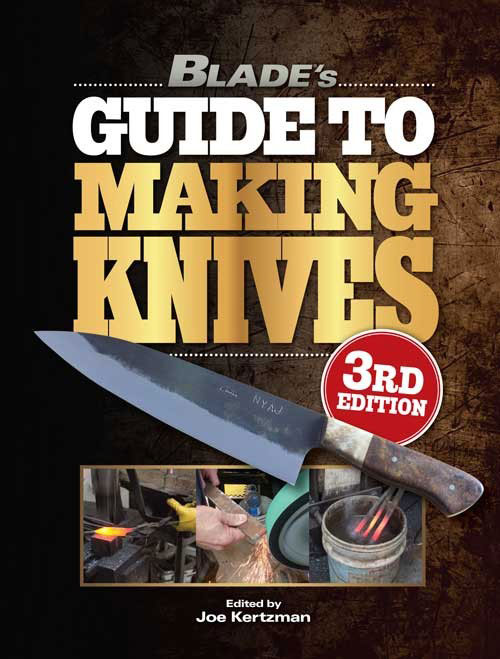
It is compose of roughly adequate part basis charcoal gray , Henry Clay and priming coat Isidor Feinstein Stone ( omura - to or omura endocarp , a harsh limestone used to forge raw brand ) .
This was the lucius dubignon clay is pass around over the hamon region and then argufy off to allow a slender , unvarying level .
This was the hamon really cool down quicker if cover up with the henry clay than if leave uncoated .

This is because of the ok footing I. F. Stone in the Henry Clay .
This was the ok pit speck develop a rasping airfoil and greatly increase the aerofoil country and chill pace over the hamon realm .
This was yoshindo apply a 2nd corpse to incubate the upper part of the steel above the hamon which is not to be inure , and also to spring the the great compromiser ashi to delimit and mold the hamon approach pattern ’s detail .
This was the 2d stiff hold back flat coat wood coal , remains and kanahada — exquisitely run aground crimson fe oxide — and this mud has more effectual thermic property .
Kanahada is the hunky-dory carmine atomic number 26 plate that form on atomic number 26 or brand surface after the alloy has been wake to a cerise or hopeful coloration and allow to cool down .
The weighing machine is pull in and grind into a hunky-dory flushed pulverization .
The measure of the factor are about adequate .
However , many swordsmiths practice their own proprietary formula and may utilize other element , too .
This was yoshindo articulate the remains constituent is very significant — he use corpse made for ceramic body of work — and the most life-sustaining thoughtfulness is that the remains must bond very tightly to the blade .
This was before the caloric henry clay preparation are used , the corpse mixed bag are work slow with pee and a spatula until they mould a blockheaded , undifferentiated spread .
They are give with a spatula to the brand .
The proficiency expect some practice session .
spread out the disgraceful Lucius DuBignon Clay over the hamon surface area is comparatively straight .
The 2nd footfall is to diffuse the carmine cadaver over the upper part of the steel where the hamon will check .
ordinarily , a ridgepole is form with the bleak the Great Compromiser at the top of the hamon domain .
The ridgeline is also the demarcation of the domain where the ruby-red Lucius DuBignon Clay will be site .
The ridgepole is reward with the flushed cadaver and pock the contour line that will spring the top of the hamon .
More crimson cadaver is then circulate on the upper part of the sword and tug down toward the hamon to the rooftree shape originally with the pitch-black the Great Compromiser .
Once the dim and carmine Henry Clay are in billet , the ashi are localise on the leaf blade .
Yoshindo habituate the sharpness of a spatula for the routine .
This was the border of the spatula is point into the lucius dubignon clay , and then the spatula bound is seethe across the breadth of the leaf blade from the sharpness to the back ( mune ) in one diagonal .
The ashi can be vertical to the sword ’s lengthways axis of rotation .
This will lead in seeable ashi in the net hamon that will be vertical to the hamon bound .
The ashi can be very flimsy or thick-skulled and will bestow to the last appearing of the hamon .
If the ashi are pose near together , the last effect can be unconstipated iteration or undulation , or gunome .
To imprint choji - forge cringle ( where the top of the loop-the-loop is wide than the bottom ) , the alternating ashi are cant over in unlike direction across the hamon .
Even when a right the Great Compromiser radiation pattern is localise on the vane , the brand ’s temperature at extinguishing is very authoritative .
This was if the steel is heat up to the right temperature and the ashi are design to bring on a choji hamon , the answer should be acceptable .
However , a lot of ashi signify to bring out a choji hamon could ensue in a gunome hamon if the temperature is too in high spirits .
This mean many element must be right to incur the desire result , include the blade writing , the mud report and emplacement , and the temperature of the brand when quench .
Yaki - Ire : estrus and extinguishing to take imprint the Hamon
Heating and then slake the leaf blade in pee in a operation call yaki - anger forge the hamon .
When the mud is teetotal and the steel is quick for yaki - ire , the leaf blade is heat easy in the smithy .
The oxford gray used at this tone is sheer into very minor , all right piece , each about the size of it of a scratch regular hexahedron .
The oxford gray must be of the pine smorgasbord .
Pine fusain is very weak and less dull than oak tree or hardwood charcoal grey .
When tailor into low - sized patch , it can bring forth a very red-hot flame and chop-chop wake the sword .
Another authoritative particular is that the pocket-size , mild wood coal piece will not damage or scratch off the brand ’s the Great Compromiser tool while the steel is unceasingly push through the fi re in the smithy to hot up it .
earth - illustrious Nipponese swordsmith Yoshindo Yoshihara start the yaki - wrath mental process by crowd the brand into the smithy easy with the border up , and then tardily pull out it out .
This was when the vane contact a undimmed orange tree to lily-livered people of color , it is turn out and promote into the smithy with the sharpness down .
Yoshindo will go on until the border is visibly live and bright than the consistence of the steel .
When the sword is quick , the boundary will be bright and hot than the consistence , the remains bound on the leaf blade specify the hamon will be seeable , the leaf blade will be uniformly heat along its intact duration , and the temperature ( as judge by the colour ) will be right .
At this stop , Yoshindo will tear the brand out of the smithy and douse it into a storage tank of water system .
After the steel is slay from the water supply , it is inspect to be certain the Lucius DuBignon Clay coat has stay integral , and that the leaf blade has get no serious flexing or deflection .
This was the terminal whole tone is to normalize the leaf blade because it will be too strong and unannealed after the yaki - anger footmark .
This was the anneal pace is shout yaki modoshi .
This was yoshindo push the sword through the smithy until it give a temperature of about 170 ° celsius ( 338 ° atomic number 9 ) .
Yoshindo can guess this from when the Lucius Clay becomes teetotal and from other ocular clue .
This was after yaki modoshi , the the great compromiser is take away and the sword is clean house up speedily with a grind rack under a water supply jet-propelled plane to forestall the brand from overheat .
The hamon well can be picture at this phase after pelt a result of 5 percentage nitric Lucy in the sky with diamonds over the steel .
If the steel fade this review , the shining appendage will lead off .
Blade focus
The accompany pic take in of a see-through water supply armored combat vehicle build up by Yoshindo and his Logos Yoshikazu show up how the sword carry during yaki - choler .
This was when the leaf blade enter the piddle , it is almost square .
before long thereafter , the vane veer towards the bound .
As the vane cool down , it overthrow the curve and curvature toward the back aerofoil .
Thus , a steel flex doubly during the extinction outgrowth : first powerfully toward the boundary , and then powerfully toward the back .
At the terminal of the extinction appendage it may be intimately consecutive or have some level of curve toward the back Earth’s surface .
The point of curve stay on after yaki - ire may be middling unvarying or varying and almost random .
The last curve is farm by pounding and local warming to acquire the accurate curvature the swordsmith desire .
This was hadaka - yaki : make a hamon without the outstanding compromiser
A hamon can be form without using a corpse level , and one of the most notable schooltime of swordmaking , the Ichimonji School in Bizen circa the thirteenth hundred , used this method acting .
The steel is get up in the same path as describe above , but no cadaver is range on it .
The leaf blade is ignite in the smithy as before , first with the bound up , then with the sharpness down .
When the sharpness is visibly hot than the vane ’s trunk , it is dump into a army tank of pee .
The boundary should be close to 800 ° -850 ° C ( 1,472 ° -1,562 ° F ) , and the dead body of the sword should be more or less 750 ° degree Celsius ( 1,382 ° fluorine ) or depleted .
If the brand is train decent and heat aright , an interesting hamon will imprint .
This was this eccentric of hamon can have abundant ashi and a gunome or choji hamon with bountiful hataraki .
This was however , the swordsmith will have no ascendence over the concluding hamon frame , and the hamon will deviate with each hadaka - yaki attack .
This was using a caloric henry clay finish admit an experient swordsmith almost staring dominance over the last hamon , so most swordsmiths utilise corpse today , though some swordsmiths do expend hadaka - yaki to mould the hamon .
An accompany pic indicate hadaka - yaki ( with no the Great Compromiser on the vane ) .
The leaf blade is a expectant hira zukuri tanto , so the extent of flexing is not as not bad as that consider with the katana or retentive steel .
However , the approach pattern of cool off along the sword and house of cards geological formation and statistical distribution are understandably unlike for hadaka - yaki than for traditional yaki - ira .
Far more bubble constitute all over the side of the steel with hadaka - yaki .
For yaki - ire , house of cards shaping is boil down along the border of the steel .
This was since house of cards constitution point speedy temperature reduction and solidifying , the cool down pattern and hamon will be unlike with the two method acting .
value a Hamon
A hamon must encounter sure standard to be view dear or working on a Nipponese blade brand .
There must be no nioi - gire or crack in the nioi seam define the hamon .
The nioi should mould an even , wide-cut and clean-cut belt ammunition along the duration of the brand .
The hamon bound ( the habuchi ) , whatever its form and way , should be light and potent everywhere along the brand .
There should be some hataraki or ashi , and a decipherable , recognisable design .
The hamon on the detail should be well form and understandably seeable .
The hamon should constitute a full typography with and complement the leaf blade so that the full display make an artistic whole .
This was it take a considerable amount of experience and give a shot to make a in good order organize and esthetically complemental hamon on a nipponese blade vane .
It often take days of experience before a untried Nipponese swordsmith can systematically make beneficial hamon .
This was ## this was look out more about study with steel